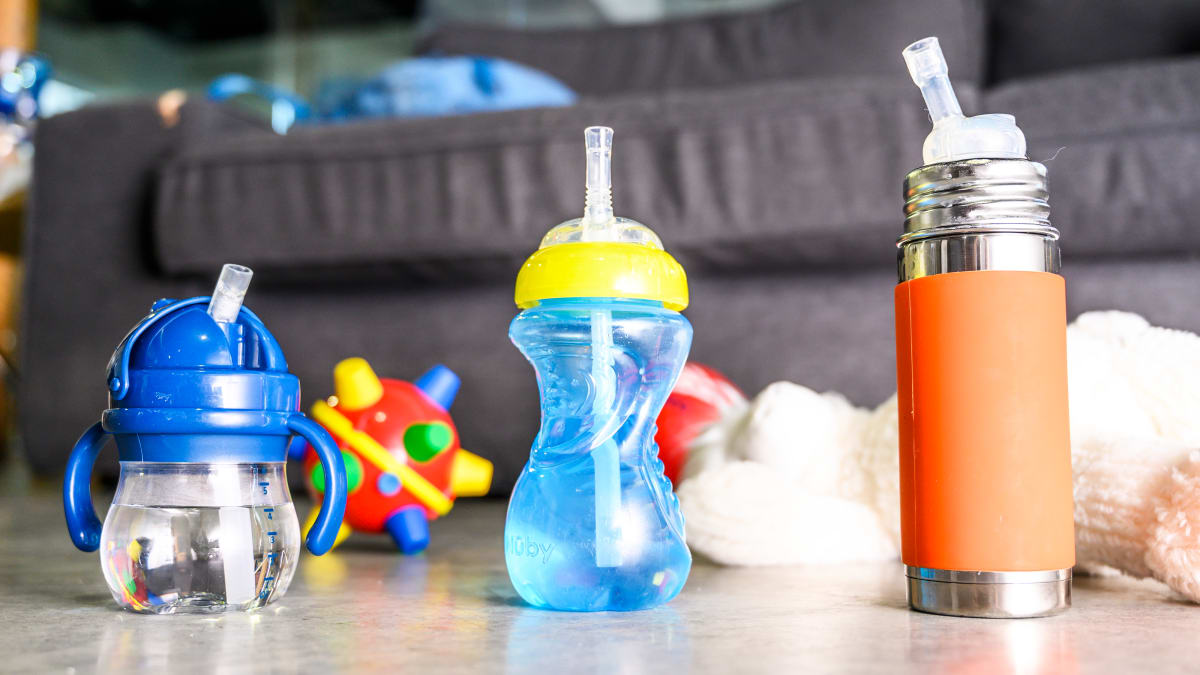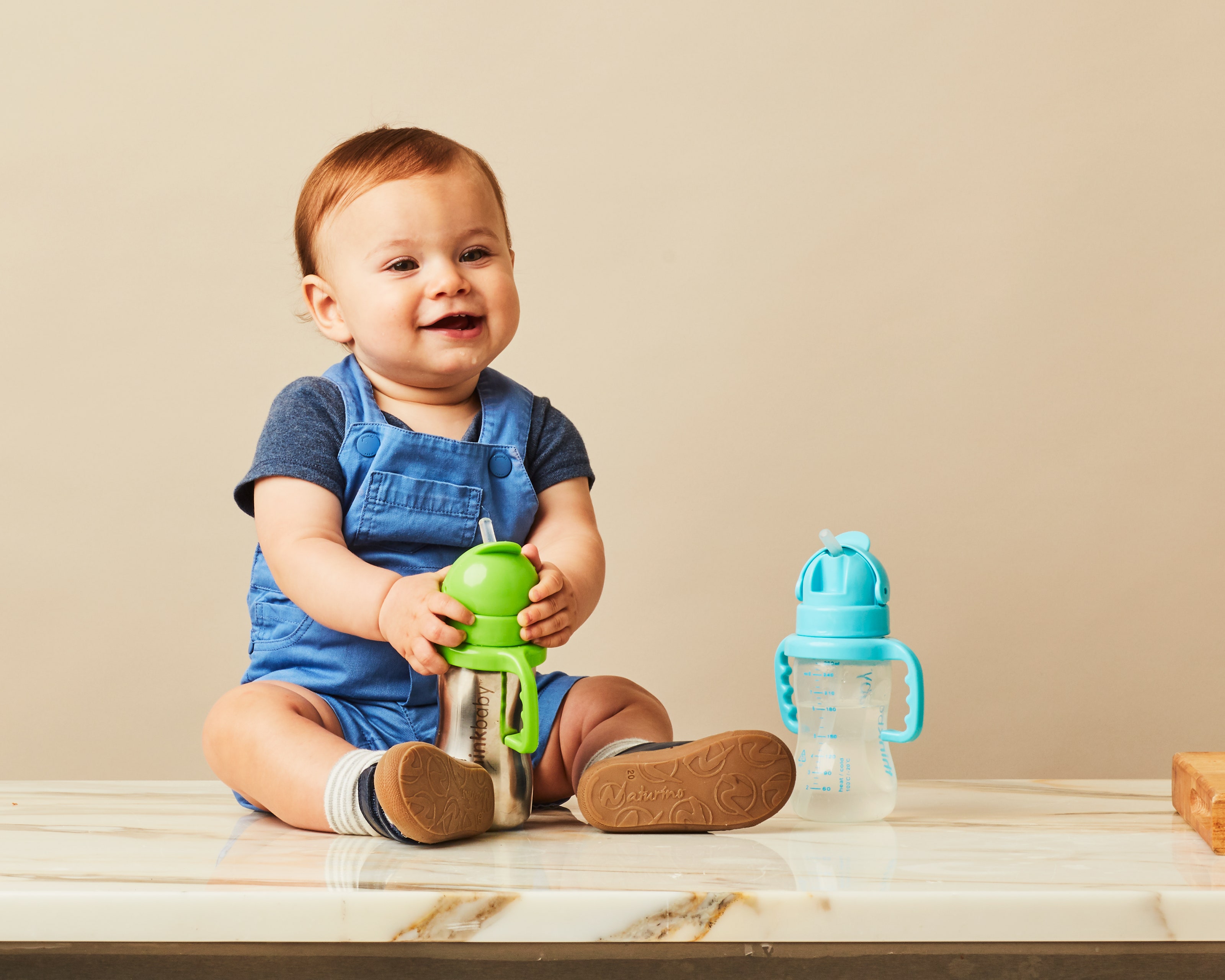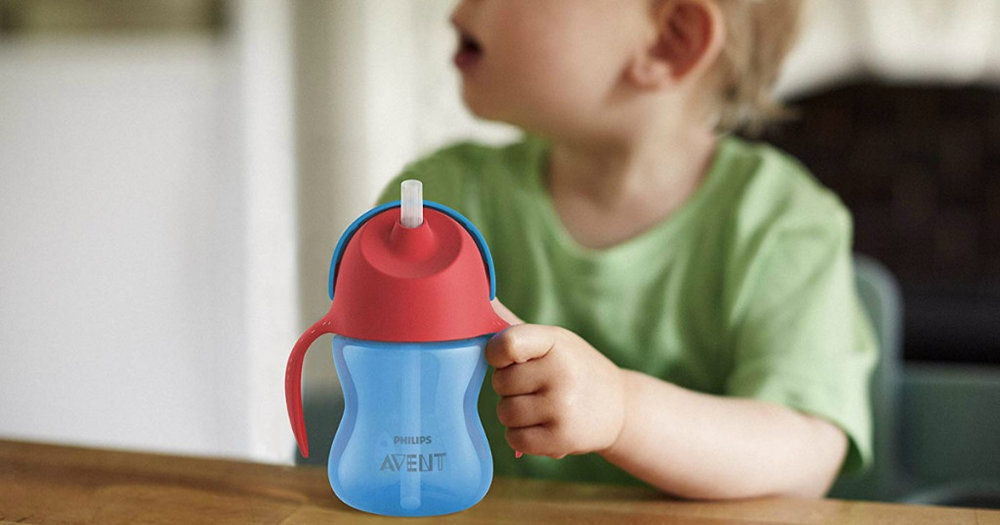Straw cups are appropriate for babies who want to drink like their parents, but don't know how to lift/tip a regular open-top cup (or don't care about proper technique). These cups have a spout that seals when not in use and dispenses fluid when the child sips on the tip.
This minimizes the mess and spills associated with standard open-top cups, while still allowing your baby some independence and autonomy over meals and beverages.
What age a baby should be?
The general consensus is that straw cups can be used as early as 6 months old, but it really depends on the child's ability to drink from an open cup. Parents should always consult with their pediatrician to make sure that their child is ready for a straw cup and to get specific instructions on how to use it safely.
Transition to straw baby cups
If your baby is used to drinking from a bottle, transitioning to a straw cup can be tricky. Discourage them from using the bottle as a crutch by slowly reducing the amount of milk or formula in each bottle until they're ready to drink from a straw. Once your baby is consistently drinking from a straw cup, you can start weaning them off of the bottle altogether.
To teach your baby use a straw cup:
- Sit them in a highchair or at the counter with the straw cup so they can see it and reach it easily.
- Put a small amount of fluid (breast milk, formula, water) in the straw cup.
- Show your baby how to suck on the straw to get the fluid out.
- Encourage them to drink from the straw cup by themselves. If they're having trouble, help them by sipping from the straw yourself.
- Repeat until your baby is able to drink from the straw cup independently.
Types of straw baby cups
There are generally two types of straw cups:
- Silicone Straw Cups
- Hard Plastic Small Cup with a Flexible Straw
Silicone straw cups are the easiest to clean and maintain, but they can also be more expensive and less durable. Hard plastic small cups with a flexible straw will be cheaper in the long run, but may present difficulties when it comes to thorough cleaning. It is up to you which type of cup you choose based on your priorities and budget.
PLASTIC straw baby cups are usually the cheapest ones on the market, so this is a good choice if you're looking for something basic. However, the chances of bacterial growth inside them increase when they are not cleaned correctly.
SilICONE cups are usually more expensive but have some unique features that make them appealing to parents who want their children's teeth to stay strong and healthy for years to come. The non-slip soft spouts are especially great for babies who are just learning how to drink from regular drinking glasses because they don't need too much effort to get anything out of them. Silicone also doesn't contain any harmful chemicals or BPA.
It's been established that children who use sippy cups have 2-3 times more tooth decay than those who do not use them at all, so opting for a straw baby cup instead of a soft spouted one is the best choice for your child teeth-wise.
Cleaning
Silicone cups are easier to clean than hard plastic ones, but they also need to be replaced about once a month or so because of wear and tear. Hard plastic straw baby cups can't usually go in the dishwasher, so it may require some more effort on your part to keep them squeaky clean.
No matter which type of straw cup you choose for your child, always remember that these types of drinking vessels should only be used until your child is at least 12 months old or until he/she shows signs of being able to drink from regular open-top drinking glasses without any spills. After this point, children should transition fully to normal drinking glasses since sippy cups aren't really necessary after one year of age.
Tooth and baby cup hygiene are important, so make sure to clean your child's straw cup after each use. Rinse it with hot water and soap and let it air dry. If you're using a hard plastic cup, you can also use a toothbrush to scrub the inside of the straw.
Bacteria love moist environments, so don't let your child's straw cup sit around wet and dirty. It may be a pain to clean regularly, but it's definitely worth it for both your child's health and hygiene!

Considerations while choosing a straw cup
When looking for a straw baby cup, you'll need to consider the age and eating habits of your baby so you can pick out a cup that is both safe and convenient. There are also some other factors you should pay attention to when making your purchase:
- Weight limits - these limits will usually be specified in the description or on the product page online because not all straw cups are meant to support heavy children. Make sure that your child's bottle/cup can support their weight before leaving them alone with it!
- Dishwasher-safe – this feature depends on what type of material makes up the actual drinking container. If it's made from silicone or plastic, dishwasher-safe properties could be offered/non-existent.
- Materials used - make sure to check what type of materials are used in the making of the straw cup you're buying for your child. They should be safe and made from non-toxic materials that won't leach harmful chemicals into their drinking water (which is usually acidic enough on its own).
- Size – smaller cups are usually better for little babies who haven't yet mastered how to drink from regular glasses. It's also better to have more than one small straw cup since they shouldn't be left alone with liquids inside them after use because they can potentially spill if knocked over easily due to their small size. Larger straw cups may be suitable for older toddlers but some come with anti-spill mechanisms which may be beneficial.
- Ease of use – straws that curve down into the cup are usually easier for children to suck on than straight straws. Some cups also come with valves to prevent spills, however, these can sometimes make it difficult for young children to drink from them.
- Price - straw cups can range in price anywhere from a few dollars to upwards of $30 so make sure to set your budget before you start shopping!
- Additional features - some straw cups come with handles that can help toddlers grip onto the cup easily or are designed in fun and interesting colors and patterns which will appeal to kids.
Top-10 picks for the best straw cup for baby
There are many different straw cups on the market, but we have compiled a shortlist of the top three picks based on consumer ratings and reviews.
- Philips Avent SCF690/27 My First Straw Cup - this cup is designed with a soft silicone spout that is gentle on your baby's gums and teeth. The cup is also easy to hold and has a non-slip grip. It comes with a snap-on lid to keep the contents inside while not in use and is dishwasher safe.
- Tommee Tippee Explora 360° Drinking Straw Cup - this cup was designed with toddlers in mind, as it is made of hard plastic and has a durable straw that can be angled in any direction. The cup is BPA-free, comes with a travel lid, and is dishwasher safe.
- Sassy Soft Spout Straw Cup - this soft spouted straw cup is designed for babies as young as 6 months old. It is made from silicone and has a textured surface to help your baby grip the cup. The cup is dishwasher safe and comes with a snap-on lid.
- 360° Degrees Leak-Proof Straw Cup - this cup is made of hard plastic and has a 360° rotating straw that can be positioned in any direction. The cup comes with a flip-top lid and is dishwasher safe.

- Munchkin Miracle 360° Sippy Cup - this cup is made from hard plastic and has a soft spout that flips back into a closed position when not in use. The cup comes with a snap-on lid and a "floating duck" that must be positioned correctly before the cup can be filled.
- First Years Take & Toss Spill-Proof Straw Cups - these cups are made of hard plastic and have an easy to hold design. They are perfect for babies who are just learning to drink by themselves, as they feature SUPER VALVES™ that prevent spills even if the child pulls it over on its side or upside down.
- OXO Tot On-the-Go Stacking Straw Cup - this cup is made of hard plastic and has a stacking design, which makes it easy to store when not in use. The straw collapses down completely inside the lid, making it less likely for your baby to pull over on its side or upside down.
- MAM Trainer Cup - this cup is designed with the anti-leak protection of AIRTIGHT SEAL technology that helps make sure none of the liquid comes out until your baby puts her lips on the spout. This keeps your baby from spilling her drinks every time she picks up or moves about with the cup. The trainer handles are great for babies learning how to hold their own cups.
- Evenflo Feeding Silhouette Hard Spout Sippy Cups - these cups feature an ergonomic spill-resistant design that allows your baby to hold them easily. They are made of hard plastic and come with a snap-on lid.
- Philips Avent Natural Drinking Cup - this cup is made of silicone and has a soft spot for your baby's sensitive gums and teeth. It comes with a protective lid to keep the contents inside when not in use, or when you're on the go. The cup is dishwasher safe.
Bottom line
There are many different straw cups on the market, but the ones listed above are some of the best based on consumer ratings and reviews. So, before you go out and buy one, make sure to do your research and figure out which one is best for your baby.
